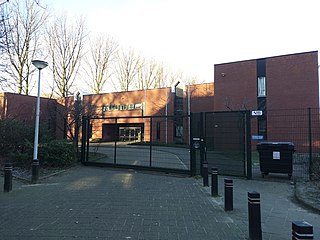
Charlottenburg-Wilmersdorf is the fourth borough of Berlin, formed in an administrative reform with effect from 1 January 2001, by merging the former boroughs of Charlottenburg and Wilmersdorf.

Wilmersdorf, an inner-city locality of Berlin, lies south-west of the central city. Formerly a borough by itself, Wilmersdorf became part of the new borough of Charlottenburg-Wilmersdorf in Berlin's 2001 administrative reform.

Halstenbek is a free municipality in the district of Pinneberg, in Schleswig-Holstein, Germany. It is situated on the north-western border of the city of Hamburg and approximately 5 km southeast of Pinneberg.

Japanese in the United Kingdom include British citizens of Japanese ancestry or permanent residents of Japanese birth or citizenship, as well as expatriate business professionals and their dependents on limited-term employment visas, students, trainees and young people participating in the UK government-sponsored Youth Mobility Scheme.

Kalk is the Eighth borough or Stadtbezirk of Cologne, Germany. Kalk was merged into the city of Cologne in 1910, the borough was formed in 1975.

Japanese people in the Netherlands include expatriates from Japan and their descendants, as well as Dutch citizens of Japanese ancestry.
Japanese people in France are French residents and citizens of Japanese ancestry, including both those who have settled in France permanently and those born in the country, along with a significant community of short-term expatriates who spend at most a few years in the country before moving on.

Halensee is a locality (Ortsteil) of Berlin in the district (Bezirk) of Charlottenburg-Wilmersdorf. Halensee was established as a villa and tenement settlement in about 1880, in the suburb of Wilmersdorf, which became part of Greater Berlin in 1920. In 2004, Halensee became its own Ortsteil. With an area of 1.27 km2 it is the smallest Ortsteil in Berlin after Hansaviertel.

Sülz is a municipal part of Cologne, Germany and part of the district of Lindenthal. Sülz lies on Luxemburger Straße between Lindenthal and Klettenberg. Sülz has 35.475 inhabitants and covers an area of 5,17 km2.
There is a small Japanese community in India which consists mainly of expatriates from Japan or Indian-born people of Japanese ancestry.
Japanese people in China are Japanese expatriates and emigrants and their descendants residing in Greater China. In October 2018, there were 171,763 Japanese nationals living in the People's Republic of China, and 24,280 Japanese nationals living in the Republic of China (Taiwan).

The Japanese School of Rotterdam is a Japanese international school in Hillegersberg, Rotterdam.

The Japanische Schule in Hamburg e.V. is a Japanese international school located in Halstenbek, Schleswig-Holstein, Germany, within the Hamburg Metropolitan Region.

Japanische Internationale Schule München e.V. is a Japanese international school in Sendling, Munich, Germany. It serves both elementary and junior high school levels.

Japanische Internationale Schule Frankfurt e.V. is a Japanese international school in Frankfurt - Hausen, Germany.

Hoshū jugyō kō (補習授業校), or hoshūkō (補習校), are supplementary Japanese schools located in foreign countries for students living abroad with their families. Hoshū jugyō kō educate Japanese-born children who attend local day schools. They generally operate on weekends, after school, and other times not during the hours of operation of the day schools.
Colegio Japonés Auxiliar de Quito is a supplementary Japanese school located in the Pusuquí area of Quito, Ecuador.

The Japanese Language School of Greater Hartford is a supplementary Japanese language school located in the Greater Hartford area of Connecticut. It is Connecticut's oldest hoshū jugyō kō. The school has 74 students as of September 2022 and is recognized by MEXT for teaching a curriculum equivalent to that of schools in Japan for students at the same grade level.
A Japanese supplementary school provides supplementary Japanese education to Japanese residents living abroad. There are three major Japanese supplementary schools in Australia, all designated by MEXT as a Hoshū jugyō kō, providing Japanese education to Japanese Australians and Japanese nationals on weekends.


















